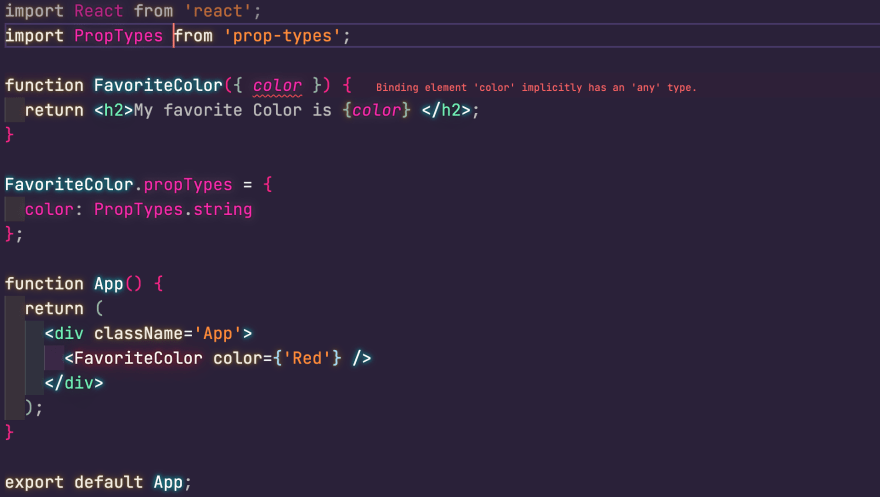An Interest In:
Web News this Week
- April 19, 2024
- April 18, 2024
- April 17, 2024
- April 16, 2024
- April 15, 2024
- April 14, 2024
- April 13, 2024
Prop types in React and TypeScript
Cover Image by Scott Webb on Unsplash
PropTypes provide built-in typechecking capabilities when writing a React app. Checking the type of prop in a React component in a large application helps catch bugs at run-time.
Typically in a React app, you will need to install the package yarn add prop-types. Then, inside a component, explicitly define the type of a prop.
import React from 'react';import PropTypes from 'prop-types';// A component that accepts "color" propfunction FavoriteColor({ color }) { return <h2>My favorite Color is {color}</h2>;}FavoriteColor.propTypes = { color: PropTypes.string};// Parent componentfunction App() { return ( <div className='App'> <FavoriteColor color={'Red'} /> </div> );}export default App;Above code snippet will run fine, and there no errors or warnings yet. If you use VSCode, hover over the prop color in the App component. You will see the expected data type on the prop.
But what if in the App component, the value of prop color is changed to a number by mistake. The component will still render in the web browser.
function App() { return ( <div className='App'> <FavoriteColor color={120} /> </div> );}But if you open the browser's Developer Tools and go to console, you will see the error.
The prop-types package provide validation at run-time. Not a great developer experience (imagine large applications). Using TypeScript in a React application can make the developer experience better.
PropTypes with TypeScript and React
Take the previous code snippet, copy it in a .tsx file. Here is how the components will look. Notice the red squiggly line beneath the prop color.
TypeScript is smart enough not to compile the code if a prop has a type of any.
Inferring PropTypes in TypeScript
PropTypes package offers InferProps that enables to infer the types for an existing prop-type definition on a component. It uses the @types/prop-types package to create type definitions.
To use InferProps, import it from the prop-types library and then define type declarations on the components prop.
import PropTypes, { InferProps } from 'prop-types';function FavoriteColor({ color }: InferProps<typeof FavoriteColor.propTypes>) { return <h2>My favorite Color is </h2>;}FavoriteColor.propTypes = { color: PropTypes.string};Code compiles, and there are no errors.
Using type keyword to declare prop type definitions
TypeScript comes with a type keyword. It can be used to define prop types without using the prop-types package.
type Props = { color: string;};function FavoriteColor({ color }: Props) { return <h2>My favorite Color is {color} </h2>;}The VSCode IntelliSense will detect the type of color prop in the App component. It will allow you to provide anything other than a string value for this prop.
Props are required in TypeScript
Another difference to notice here is that, with TypeScript, all props required by default. In the prop-types package, all props are optional by default. To make a prop required, you will have to use .isRequired explicitly.
With TypeScript, that is not the case.
Optional props in TypeScript
If a component has an optional prop, add a question mark when declaring prop type:
type Props = { color?: string;};Thank you for reading, and let's connect!
Thank you for reading my blog. Feel free to subscribe to my email newsletter and connect on Twitter
Original Link: https://dev.to/amanhimself/prop-types-in-react-and-typescript-1kph
Dev To
 An online community for sharing and discovering great ideas, having debates, and making friends
An online community for sharing and discovering great ideas, having debates, and making friendsMore About this Source Visit Dev To






